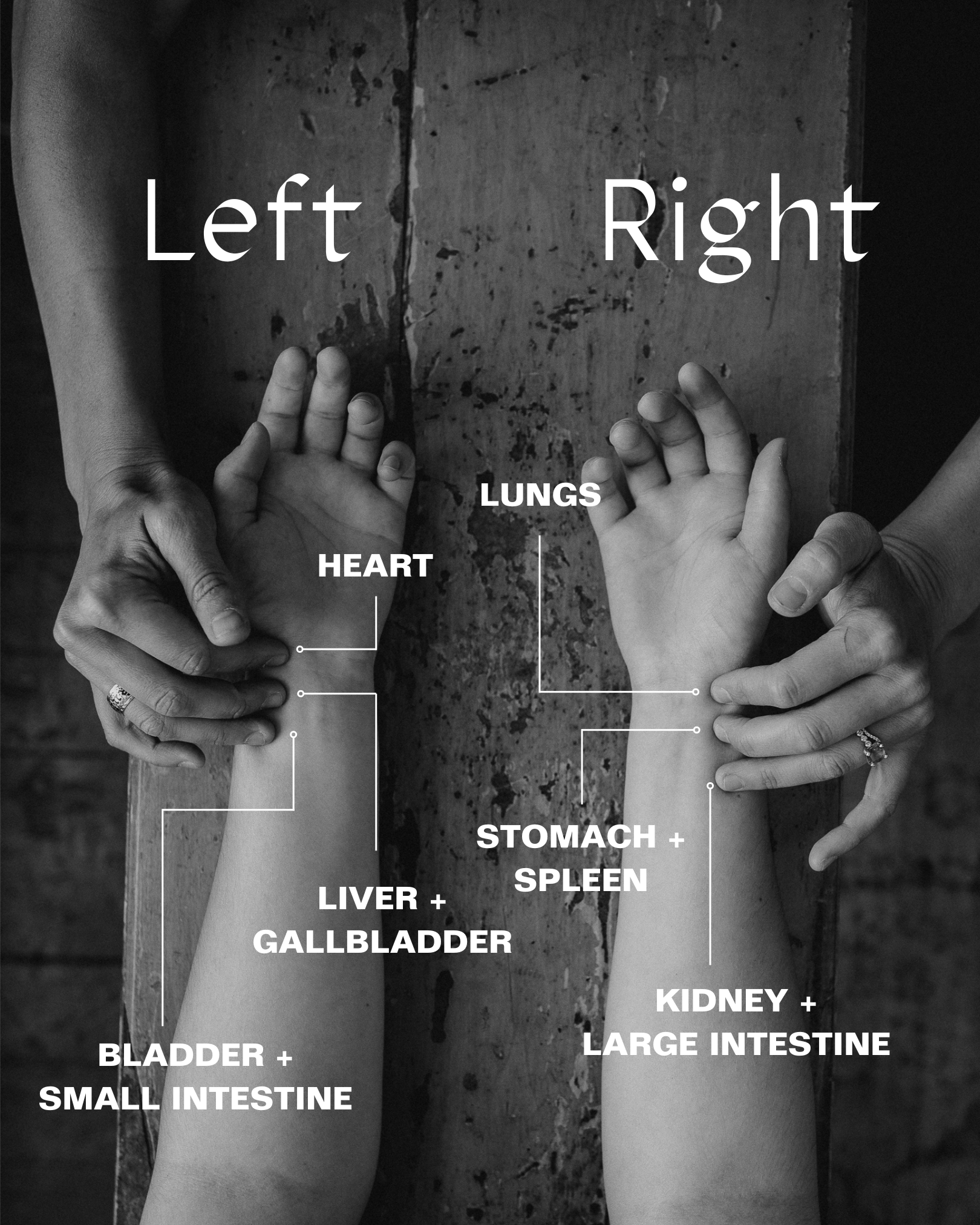The Body Speaks: Traditional Chinese Medicine (TCM) Diagnosis
Traditional Chinese Medicine (TCM) is an ancient medicinal system that originated in the Asian continent and has globally evolved over thousands of years. TCM’s main objective is to restore the balance of yin and yang energies while preventing and/or actively addressing health conditions.
During a client consultation, a practitioner will conduct a TCM diagnosis, which evaluates specific physical signs that may indicate imbalances within the body. At the Wildflower Clinic, our lead practitioner, Dana, uses this primary diagnostic tool to ensure she’s on the right path toward uncovering underlying triggers of health conditions. With more than a decade of clinical experience, Dana has used the TCM diagnosis method to understand a wide range of health presentations and create hundreds of successful health protocols that help restore the vital life force (qi - pronounced “chee”) within her clients.
TCM Diagnosis
Conducting a TCM diagnosis is an art and skill meant to uncover body systems that are unbalanced and negatively affecting the energetic flow of the Zang Fu organs. (The Zang Fu organs correlate with the anatomical organs, but unlike Western medicinal practices, the Zang Fu organs represent the energetic communication of meridians in the body, as well as spiritual, and physiological significance.) A practitioner will study physical manifestations of the tongue, pulse, skin, and nails in great detail to detect certain imbalances. This examination, along with information presented during a client consultation, can lead a practitioner to a “TCM diagnostic pattern” that allows for deeper understanding of the underlying triggers causing organ disharmony.
Unveiling a diagnostic pattern(s) will help the practitioner create a client’s health protocol. These patterns highlight the status of a specific organ or substance within the body. For example, some of the most common patterns/diagnoses we see at the Wildflower Clinic include:
Qi Deficiency
Excess Yang
Blood Stagnation
Dampness
Sinking Yin
Each one of these patterns helps to shed light on an underlying trigger.
Completing a TCM Diagnosis
When completing a TCM diagnosis, a practitioner will observe specific characteristics of the tongue, pulse, skin, and nails that may suggest an imbalance.
Tongue diagnosis
The tongue holds great significance in TCM as the areas of the tongue correlate with different organs. A practitioner considers five aspects when completing a tongue evaluation. These aspects consist of:
Vitality of the tongue (whole tongue color, vital color, or tongue’s “spirit”)
Body color (color underneath the coating of the tongue)
Body shape (cracks? bumps?)
Tongue coating (thickness? white? yellow?)
Moisture (wet? dry?)
Since different parts of the tongue represent varying organs (see diagram below), if a characteristic presents itself in a specific area, this discloses valuable health information about that organ.
Pulse diagnosis
A TCM pulse diagnosis is a subjective procedure that reveals the relationship between qi, blood, and the Zang Fu organs. A practitioner will check a client’s arterial pulse, which is formed by the flow of qi and blood within the body. There are 29 different types of pulses in TCM. When checking the pulse, a practitioner will look for characteristics that diverge from a normal pulse, described as:
calm
smooth
soft, but not too soft, and not slow
rapid
rough
hard.
As seen in the diagram presented, certain positions of a pulse (distal, middle, and proximal) may indicate disharmony in one of the Zang Fu organs.
Skin diagnosis
Skin appearance is another important indication of a person’s health. Discoloration, acne, and uneven pigmentation are all examples of imbalances that will support a successful TCM diagnosis. Like the tongue and pulse, specific areas of the face correlate with Zang Fu organs, giving a practitioner a map to understanding these imbalances.
Nail diagnosis
The last TCM diagnosis inclusion is the observation of the nails. Size, strength, inconsistencies, and color all give clues to a client’s current health condition. For instance, white spots on the nails can indicate that the client has a magnesium or zinc deficiency.
Understanding the Body in TCM
To understand a TCM diagnosis pattern, we must look at TCM’s 5 major functional entities. These entities include: the substances, Zang Fu organs, Jing Luo (meridians), Jing Mai (12 channels), and Luo Mai (8 containers or vessels).
Substances are vital contributors to the balance of yin and yang and consist of Essence (congenital and acquired), Qi (vital life force), Shen (spirit), Blood, and Body Fluids. There are two types of essence or “Jing”; congenital essence and acquired essence. Congenital essence is passed down from the parents and is stored in the kidneys where it promotes the physiological functions of maturation, growth, and reproductive development. Acquired essence is derived from nutrients, lifestyle choices, and environment, and promotes the physiological functions of the Zang fu organs.
Both essences nurture one another while they nourish the body.
Qi is considered the vital life force that interconnects all living things within the universe and flows throughout the body (with blood) via channels and meridians. These meridians (Jing Luo) and channels (Jing Mai) join the Zang Fu organs to create a harmonious relationship.
Essence sets the tone for qi within the body, and qi sets the tone for shen (spirit /soul).
There are five Zang (yin) and six Fu (yang) organs, plus the Pericardium (the membrane that encloses the heart). The yin organs are dense cavities consisting of the Liver, Spleen, Lungs, Heart, and Kidneys. In these organs, fundamental substances (qi, blood, and body fluids) are produced, managed, and stored. The six yang organs are hollow cavities where food is digested and nutrients are released to nourish the body. They consist of the Stomach, Small Intestine, Large Intestine, Bladder, Gallbladder, and Triple Burner (the trunk of the body divided into three different sections).
When qi flows effortlessly throughout the meridians and channels, and the Zang Fu organs are working in harmony, there is balance and health within the body.
The TCM Process
When evaluating a client, a TCM practitioner uses the TCM diagnosis method to support evidence and information disclosed during a consultation. Although much can be divulged from a TCM diagnosis, it takes years of practice to masterfully read these conditions and notice subtleties that may present. Along with this tool, 1-on-1 consultations (which may include suggested lab testing) are necessary to provide the practitioner with information needed to create a customized health protocol.
If you’re interested in learning more about the process at the Wildflower Clinic, we invite you to enroll in our Tongue, Pulse, and Nail Diagnosis online course.
You can also schedule an in-person or virtual 1-on-1 consultation with Dana to receive your TCM diagnosis as part of your intake session.
Sources
Acupuncture. (1974). Australia: Australian Government Pub. Service.
Liu, Y., Vian, K., Eckman, P. (1988). The Essential Book of Traditional Chinese Medicine. United Kingdom: Columbia University Press.
Sacred Lotus Chinese Medicine. (2000). The 29 pulses in Chinese Medicine (TCM) pulse diagnosis. Chinese Medicine - Sacred Lotus. Retrieved from: https://www.sacredlotus.com/go/diagnosis-chinese-medicine/get/4-pillars-pulse-images-tcm-diagnosis#:~:text=The%20Normal%20Pulse%3A%20reflects%20good,%2C%20rapid%2C%20rough%20or%20hard.




